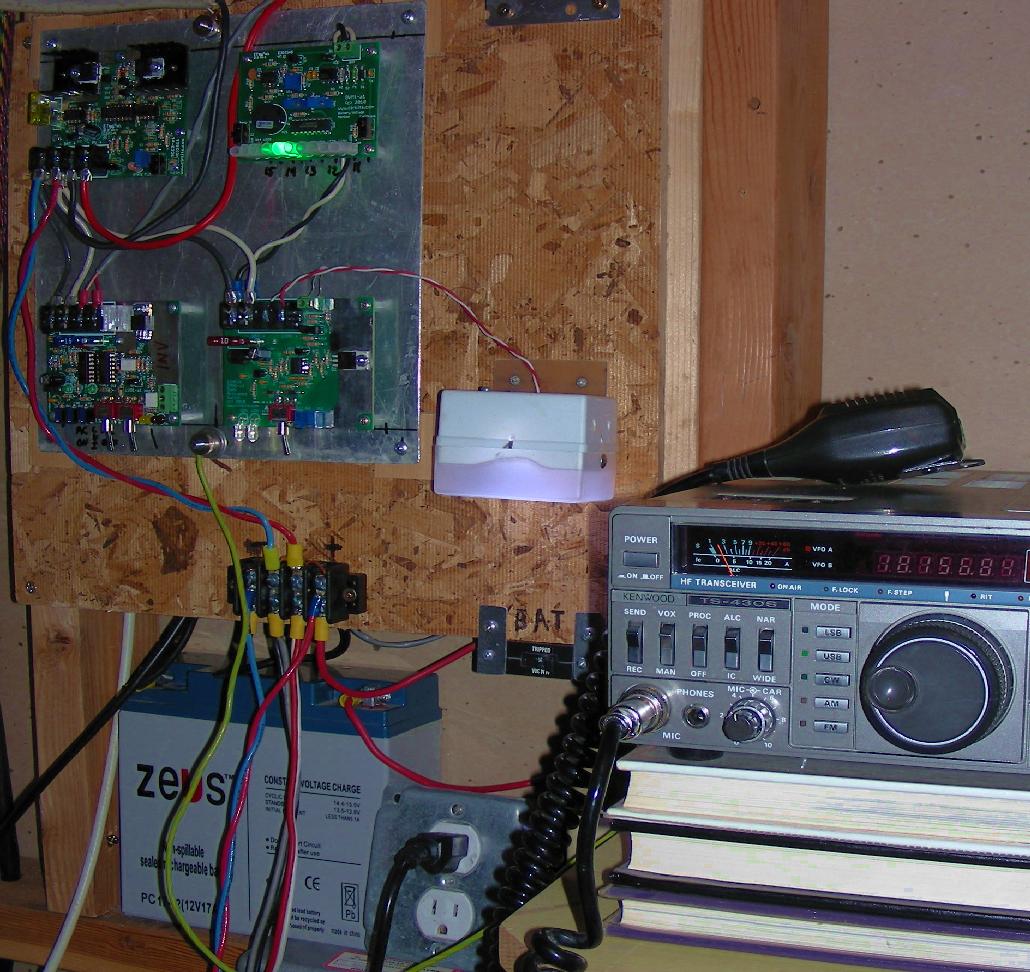
All of the kits described in this article are available from CirKits.

The original setup, the Zeus battery was replaced with a larger unit.
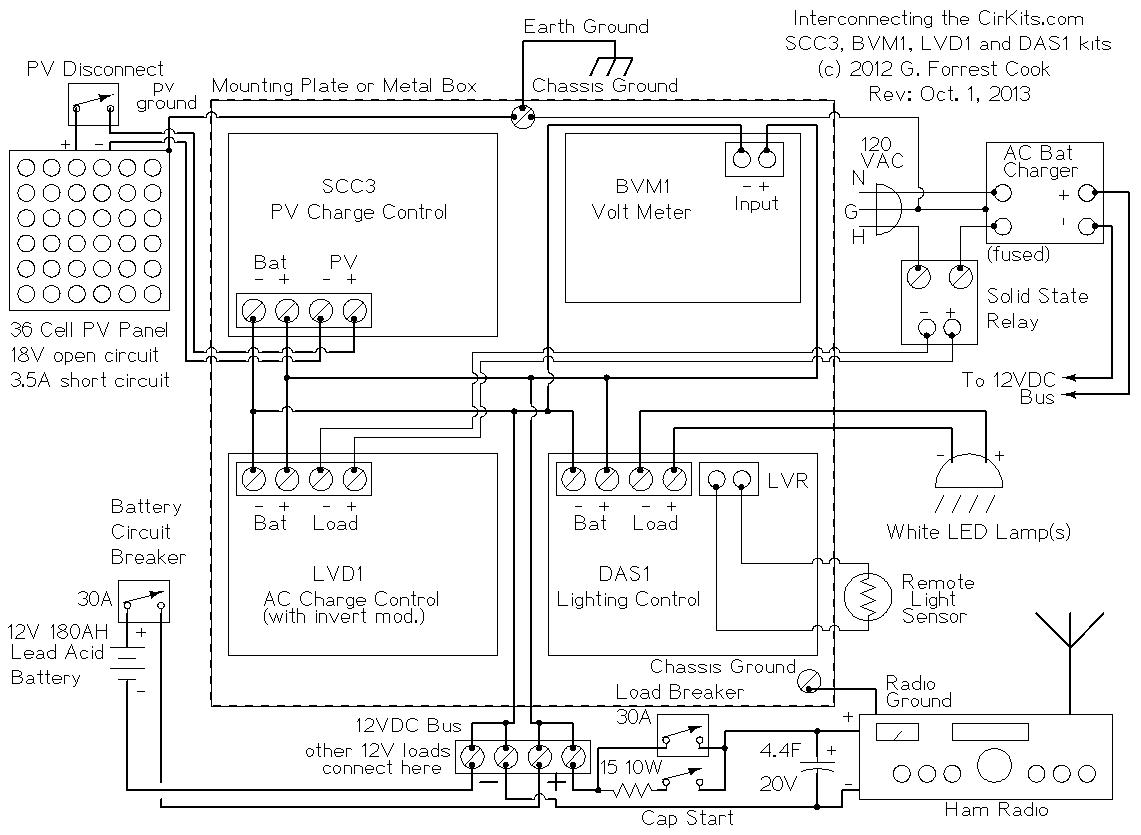
Interconnection Diagram for the four kits.
(C) 2012, G. Forrest Cook
This article shows how to power an amateur radio station from solar power using four kits that are available from CirKits.com. The kits have been designed to work together in a modular way, each kit provides a unique function. A subset of these kits can be combined if one does not need all of the functions shown here. As an example, the SCC3 and BVM1 kits could be used together for a portable ham radio power system.
The four kits shown are the SCC3 photovoltaic charge controller, the BVM1 LED battery voltage monitor, the LVD1 low voltage disconnect and the DAS1 dark activated switch. The LVD1 output inversion modification has been applied to make the circuit a low voltage connect, this allows it to turn on an auxilliary AC-powered battery charger via a solid-state relay.
Each kit provides a unique function for the assembly. The SCC3 kit regulates the solar charging of the lead-acid battery, it switches the photovoltaic current to the battery on and off to maintain a user-defined float voltage. The BVM1 kit monitors the changing battery voltage, it can also be set to beep when the battery voltage is too low.
The LVD1 kit is wired with the inverted output modification shown at the bottom of the LVD1 page. The LVD1 output controls a solid-state relay that switches on the AC power for a DC Power Supply that is used to charge the lead acid battery from AC line power.
Finally, the DAS1 kit is used to control DC operated LED lighting. The DAS1 can be set to turn on the lights automatically at dark, or when they are manually switched on. It also has a built-in low voltage disconnect feature that shuts the lights off if the battery voltage drops too low.
When used together, the four kits allow an amateur radio station to run automatically from solar power when the sun is shining and from AC power when the sun is down. Additionally, the high-discharge capability of the lead acid battery can provide more than 20 amps of current when transmitting, but only requires a small DC power supply for recharging. This eliminates the need for an expensive 20 Amp DC power supply. Operation in this manner is limited by the transmit duty-cycle that is used.
Note that all four of these kits are designed to produce very little spurious RF output. Many commercial charge controllers use switch-mode technology that radiates a lot of RF noise. DC to AC inverters also generate high levels of RF noise. An all-DC power system can be advantageous, especially when operating on shortwave frequencies.
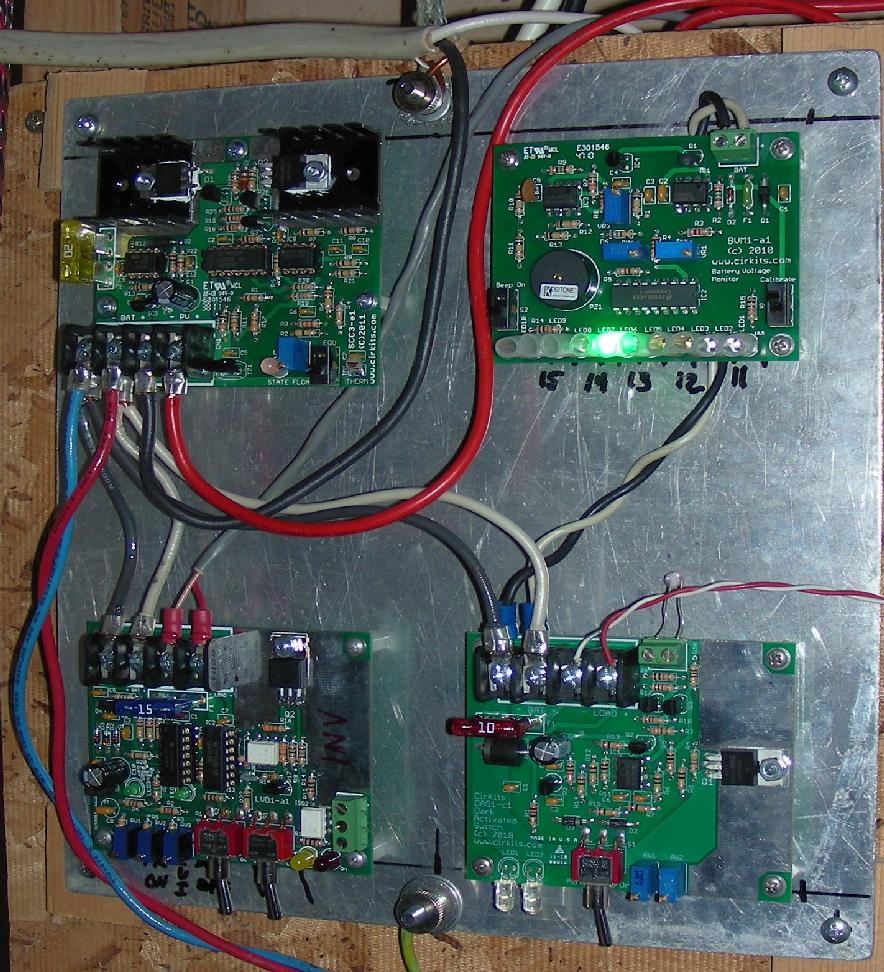
Close-up view of the four kits.
The four kits were assembled on a large sheet of aluminum using insulated spacers and 4-40 hardware. The aluminum sheet was mounted over thin wood spacers to a piece of MDF board that was screwed to the wall. The upper and lower grounding points were built with a collection of 10-32 screws, nuts, washers and thumb-nuts.
All of the high-current electrical connections were made using crimp-on spade lugs. The lugs were first crimped then soldered to the wires to assure low resistance connections. All of the current-carrying lines are made with 12 gauge stranded AC wiring, high temperature THHN insulation is recommended. Two wires were inserted into single spade lugs on the SCC3 battery connector to save space on the connector, this can be seen on the black and white wires in the photos.
A 30 amp DC-rated circuit breaker (available on eBay) was wired between the battery and the DC Bus terminals, this is essential for protection against shorts and fire. A lower current DC switch or circuit breaker should be used in series with the PV panel to allow the PV current to be shut off when servicing. If the PV panel has a built-in series diode, the diode should be shorted out. The SCC3 has a built-in low-loss Schottky diode.
The solid state relay was mounted inside of a 4"x4" electrical box with an outlet cover, this is shown next to the lead acid battery in the photograph. The DC power supply is plugged into the same box and an AC cord is routed into the box with a standard romex cable clamp.
The PV panel's frame is bonded to a third conductor in the PV feed wire, that is grounded to the aluminum panel. The aluminum panel is grounded to a nearby copper cold water supply pipe, which also serves as the main shack ground.
The SCC3 kit can be calibrated in-circuit, it should be set to float the battery at around 13.8V (depending on the battery type). The other kits should be calibrated out of the assembly using the calibration instructions supplied with the kits. A variable-voltage DC supply and a digital volt meter should be used for accurate calibration. It may take some experimentation to select the appropriate on and off voltages for the LVD1 kit. Turning the AC charger on at 12.3V and off at 13.6V is a good starting point.
Operation of the main DC supply is fully automatic, just turn on the ham radio and transmit when you want. The lights will flicker on the various boards as the battery voltage rises and falls. The BVM1 board has fairly bright LEDs that flash for its voltage indicator, it may be less distracting to switch the LEDs on constantly by switching the board to calibrate mode. The DAS1 board can be used to manually or automatically turn the LED lighting on and off.
The 17 Amp-Hour battery shown in the initial setup was able to run a low power (QRP) radio for quite a long time before the AC charger turned on. When transmitting with the Kenwood TS-430S for any length of time, the AC charger would turn on, and the internal resistance of the battery caused the Kenwood to dim and act badly when transmitting at full power. The original battery was replaced with a 180 Amp-Hour wet cell deep cycle battery (Super Start SSB 27DCMJ). Even this battery had trouble keeping up with the Kenwood's >20 Amp peak current drain when running at full power. One reader recommended switching to Interstate batteries, they have cylindrical cells and can apparently produce higher peak currents.
To solve the peak current problem, a Bulls 4.4 Farad 20V super capacitor (which is really 2 Farads at 16V, see below) was connected directly across the DC input terminals of the radio. These devices are commonly used as stiffening capacitors for automotive subwoofer amps and can be purchased on eBay for about $40. The capacitor has such a large surge when it is initially charged that it can easily trip a 30 amp circuit breaker. A push-button start switch in series with a 15 ohm, 10W resistor was wired across the load circuit breaker. Just push the start switch for a few seconds before closing the circuit breaker. The radio works much better with the super capacitor across its power source. The capacitor's built-in voltmeter circuitry consumes about 30mA of current when idle (360mW), the load circuit breaker should be shut off when not in use to prevent unnecessary battery cycling.
A few years after installation of the Bulls super capacitor, it stopped being effective. I dis-assembled the unit and discovered some rusty corrosion on the main terminals, which were cleaned off and re-tightened. I also noticed that the device consisted of 20 10,000uF 16V capacitors in parallel for an actual rating of 2F/16V, not the advertized value of 4.4F/20V. The container also included a cylinder of concrete to give it some artificial weight. One might say that the Bulls brand is missing the trailing letters: hit.
For even more reserve power, a pair of 6V/225 Amp-Hour golf cart batteries such as the Trojan T105 type could be used. The stiffening capacitor would still be a good addition to the Trojan battery pair. Consult the SCC3 FAQ document for information on battery and PV sizing. If you use a wet-cell lead acid battery, be sure to put the battery into a box with a small vent fan that is ducted to the outdoors. Lead acid batteries produce explosive hydrogen gas and acidic vapors when they are under heavy charge and discharge conditions.
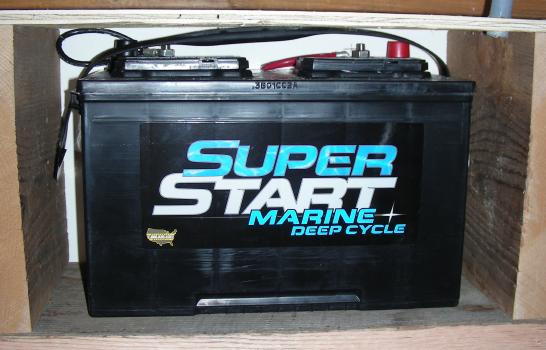
|
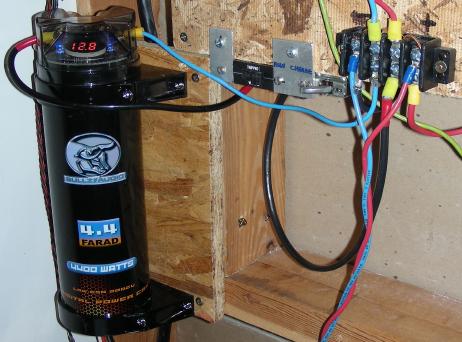
|
Back to FC's Solar Circuits page.